The Liguria Region of Italy
 Location
Location
Liguria is a coastal region of north-western Italy, the third smallest of the Italian regions. Its capital is Genoa. It is a popular region for tourists with its beautiful beaches, picturesque little towns, and good food.
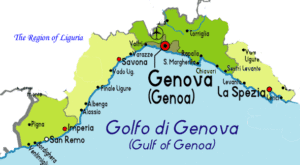
Liguria borders France to the west, Piedmonte to the north, and Emilia-Romagna and Toscana to the east. It is located on the Ligurian Sea. The narrow strip of land is bordered by the Ligurian Sea, the Alps and the Apennine mountains. Some mountains rise above 2000 m; the watershed line runs at an average altitude of about 1000 m. Liguria measures just 5,422 square kilometers of which 3524.08 kilometers are mountains and 891.95 are hills.
Climate: The hills that immediately circumvent the coast together with the sea account for a mild climate year-round. The average winter temperatures are 7 to 10°C (45 to 50 °F) and summer temperatures of 23 to 24 °C (73 to 75 °F), making for a pleasant stay even in the dead of winter. Rainfall can be abundant at times, as mountains very close to the coast create an orographic effect. Genoa and La Spezia can see up to 2,000 mm (79 in) of rain in a year; other areas instead show the normal Mediterranean rainfall of 500 to 800 mm (20 to 31 in) annually.
Geography: The coastline is generally not very jagged, and is often high. The only two exceptions are Portovenere and Portofino. There are small beaches, but there are no deep bays and natural harbors except for those of Genoa and La Spezia.
Liguria’s geography is mainly mountainous and hilly, with narrow strips of flatland along some stretches of coast and in some low flood valleys. Liguria is divided into four provinces: Genova, Imperia, La Spezia, and Savona. Genova is the capital and an important seaport. Liguria’s surface consists of mountains and hills, teeming with woods. Both the Alps and the Apennine mountains run through Liguria’s 2,092 square miles of land.
History: Because of its isolated coastline, Liguria has been inhabited since the 5th century BC by the fiercely independent Ligurian peoples. The Romans were not able to romanize these people for many centuries, and small towns like the Cinque Terre, never really conquered by Rome. After the fall of the Empire the region was ruled by Byzantine and Lombard factions, but because of its inaccessibility by land it maintained a level of autonomy that was always at risk from invasion by Saracens, Normans or Pirates. By the Middle Ages Genoa ruled the entire Ligurian province because it was a powerful maritime republic, more powerful than its rivals in Pisa and Venice. It was in the wars with Venice that Marco Polo was captured, and dictated his adventures while in a Genoese prison. Liguria was later annexed by Napoleon and given to the House of Savoy after his final defeat. This loss of independence led to Ligurian patriots like Mazzini and Garibaldi (from the Savoy city of Nice), to start the Italian Risorgimento and the final goal of the modern nation of Italy.
Culture: Mountains and steep cliffs that rise loftily out of the Ligurian Sea in the most northerly part of the Western Mediterranean makeup the fascinating landscape that impresses people on their journey through this historically rich and dynamic region. The capital Genoa, one of the most important ports in the Mediterranean and home to Christopher Columbus, was already a powerful maritime state in the Middle Ages. Today one finds impressive buildings, elegant mansions, and wonderful churches — all of which bear witness to Liguria’s glorious past and blend in perfectly with the modern city. In other parts of Liguria, there are also numerous historical treasures. Intact and luxuriant Mediterranean vegetation exists in the mountain regions of Portofino and Cinque Terra. Portovenere is a small jewel on the Mediterranean coast. Sanremo is one of Italy’s most famous bathing resorts and the place where the annual Italian pop music festival takes place. The beautiful Benedictine monastery of S. Fruttuoso merits a special visit. There are many other important historical monuments to be explored.
Liguria is where pesto originated, one of the most popular sauces in Italian cuisine. Seafood is a major staple of Ligurian cuisine as the sea is an integral part of the region’s culture. Another important feature is the beach. Tourists have been flocking to the Italian Riviera for decades to experience its calm, deep blue water.
Travel by Air:
Of Liguria’s two civil and one military airports, the Genoa Sestri International Airport or Cristoforo Colombo Airport is by far the busiest of the three. It was built on an area of reclaimed land with a runway that is two and a half kilometers long and has efficient flight and ground facilities.
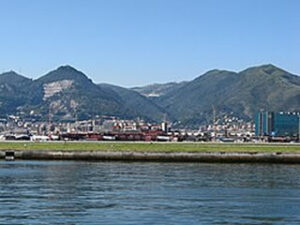 It is open all the year round, and is particularly convenient because it is in central Liguria and is only 6 kilometers from the center of Genoa. There are regular connecting flights to the main European towns, the UK and main Italian airports. Visit its website for more specific information.
It is open all the year round, and is particularly convenient because it is in central Liguria and is only 6 kilometers from the center of Genoa. There are regular connecting flights to the main European towns, the UK and main Italian airports. Visit its website for more specific information.
There is a convenient, fast and punctual hourly bus service, every day of the week, connecting the Airport with the city center and railway stations. The Volabus service connects travelers from Stazione Principe F.S. to Cristoforo Colombo International Airport in approximately 30 minutes and costs 6 euro plus a 60 minute journey on the AMT network (buses, metro, public elevators and funicular railways) in the same day.
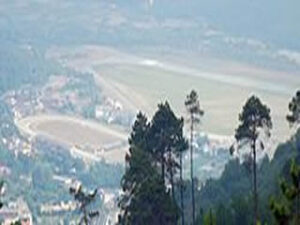 Albenga Airport, also known as Clemente Panero International Airport, now called Riviera Airport, is located 3.24 NM west of Albenga, a city in the province of Savona. It is between Savona and Imperia, approximately seven kilometers west of the town of Albenga, in the community of Villanova d’Albenga in Liguria, northern Italy. It was formerly known as Villanova d’Albenga International Airport. It generally serves the tourist area of western Liguria and is heavily used for flower exportation. Visit its website for specific information. While Monte-Carlo is less than an hour’s travel by car, a helicopter company based at the airport can connect passengers from the runway directly to the Principality of Monaco in less than 20 minutes.
Albenga Airport, also known as Clemente Panero International Airport, now called Riviera Airport, is located 3.24 NM west of Albenga, a city in the province of Savona. It is between Savona and Imperia, approximately seven kilometers west of the town of Albenga, in the community of Villanova d’Albenga in Liguria, northern Italy. It was formerly known as Villanova d’Albenga International Airport. It generally serves the tourist area of western Liguria and is heavily used for flower exportation. Visit its website for specific information. While Monte-Carlo is less than an hour’s travel by car, a helicopter company based at the airport can connect passengers from the runway directly to the Principality of Monaco in less than 20 minutes.
The third airport is located in Luni, called the Luni Airport. It has no international or intercontinental flights. The “Bartolomeo Arrigoni” airport of Sarzana-Luni ( ICAO : LIQW ) is a military airport open to civil air traffic affiliated with the Italian Aero Club d’Italia located in the municipality of Sarzana , in the locality of San Lazzaro . It is mainly an air base used by the Navy and the Coast Guard and to a limited extent also by general aviation , with the presence of a flying club.
Travel by Train/Bus:
The closest railway station to the airport is Genova Sestri Ponente-Aeroporto, served by Trenitalia regional trains to/from Piazza Principe/Brignole, Savona and Ventimiglia.
The station is then connected to the airport by a bus service called Flybus, operated by AMT, which departs with a 15 minute frequency every day between 6.00 am and 10.00 pm. Fares are €1,50 (AMT single tickets) or €1,60 (AMT+Trenitalia integrated fares).
As of 1 August 2020, regional bus operator ATP resumed its Airport Shuttle service between the airport and the other localities in Genoa’s Metropolitan City. A one way fare is €20, while a return journey costs €40. As of now, people wishing to travel on this service must book a seat at least 4 days before their travel date and must await a response from the operator’s reservation department.
The regional rail network offers conveniently timed connections to all destinations in Liguria making traveling to Liguria by train a pleasant and convenient way to explore the region.
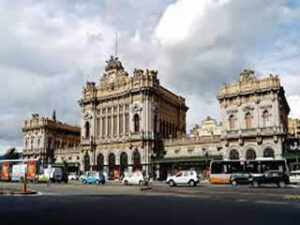
The rail network follows the route of the main highway network. The Ventimiglia-La Spezia line serves passengers of Northern Italy, from Turin on the Savona and Genoa route, from Milan on the Genoa route and from Parma on the La Spezia route, and it connects to the Tyrrhenian line to Rome, Naples and Southern Italy. Liguria is also connected by the main train lines on international routes from Nice, Mont Cenis, Gothard, Germany, Austria and Ex-Yugoslavia.
The regional trains are also the recommended way of transport when visiting the National Park of Cinque Terre. It is possible to reach the villages of Cinque Terre by car, but there is no use for a car once you are there as the Cinque Terre historical centers are closed to car traffic.
For more detailed schedule information or to buy train tickets, both national and international, consult the website for Trenitalia. Be sure to request regional trains and information for Liguria.
High speed trains including Italo and Frecciarossa stop in Genoa, and La Spezia as well as other important cities and destinations in Italy.
Travel by Car:
A trip through Liguria by car is a wonderful experience with the mountains on one side and the beach on the other, amidst tunnels and breath-taking scenery. It is great to be independent and to visit the many medieval mountain villages. Note that in some places it is impossible to drive though like Cinque Terre. Also, traffic in big cities is nerve racking. Keep in mind that gas and tolls are very expensive.
 Liguria, squeezed between the magnificent mountains and the incomparable sea landscapes of poetic beauty, is full of wonderful itineraries weaving between the coast and the interior regions. From the high mountains, to the seaport villages, beaches, to the cities of the interior parts, Liguria with its 235 municipalities offers something for everyone. The unique coastline of Liguria is known as the Italian Riviera, and there are resort towns too numerous and too famous to note. Located in northwest Italy, Liguria includes some of the most interesting cultural and environmental destinations in Italy
Liguria, squeezed between the magnificent mountains and the incomparable sea landscapes of poetic beauty, is full of wonderful itineraries weaving between the coast and the interior regions. From the high mountains, to the seaport villages, beaches, to the cities of the interior parts, Liguria with its 235 municipalities offers something for everyone. The unique coastline of Liguria is known as the Italian Riviera, and there are resort towns too numerous and too famous to note. Located in northwest Italy, Liguria includes some of the most interesting cultural and environmental destinations in Italy
Ventimiglia
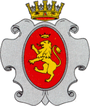 Ventimiglia might be considered the Gateway to Italia, since it is located close to the border between France and Italy. Ventimiglia has a lovely beach of small stones and is a popular summer destination for tourists visiting the French Rivera.
Ventimiglia might be considered the Gateway to Italia, since it is located close to the border between France and Italy. Ventimiglia has a lovely beach of small stones and is a popular summer destination for tourists visiting the French Rivera.
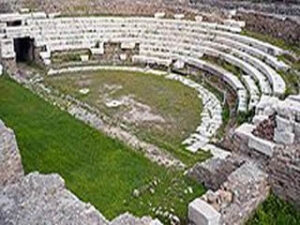
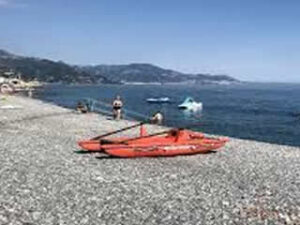
Ventimiglia is actually built atop the remains of the ancient Roman border settlement of Albintimilium. You can see the remnants of the 2nd century A.D, 5,000-seat Roman amphitheater at the eastern end of main road – the S1 – it’s an unusual sight to see this ancient monument sandwiched between the road and the railway. Visit the ruins of many other ancient buildings and traces of the city walls. There are also some ancient tombs west of the city walls.
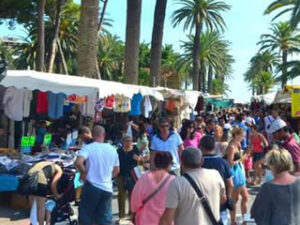
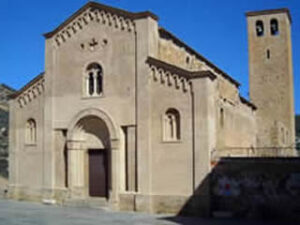
Particularly popular is the Friday open air market(left) along the beach of the new part of town.
The Church of San Michele the Archangel was built by the Counts of Ventimiglia in the 10th century as their personal chapel and was later given to the Benedictine monks of Lerino. It was built in the Romanesque style of the 11th century and then underwent reconstruction in the 12th century. This reconstruction was limited to the apse, the nave and the bell tower. Theomanesque cript was constructed using various marbles thought to be taken from the Citta` Nervina among which was a military monument from the Emperor Caracalla.
San Remo 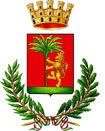
San Remo, the largest city of the Riviera Ponente, was once its glamorous crown jewel, probably up until World War II. It is located on the western Mediterranean coast of Liguria, and was once a Roman settlement. Its population today numbers about 57,000. San Remo’s harbor lies below its unusual medieval center called la Pigna, a walled village protecting the nobility from the Saracen raids. It is called La Pigna because it is an intricate maze of streets and alleyways that resemble the scales of a pinecone. A number of narrow footpaths walk wind up the hill. There are many cafes and restaurants along the waterfront. The harbor serves both pleasure boats and fishing boats bringing fresh fish in San Remo’s restaurants.
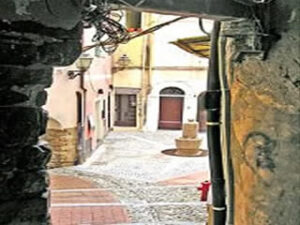
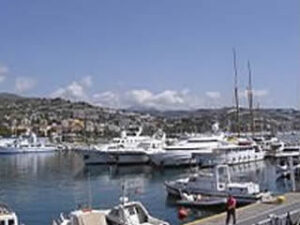
The Municipal Casino was built in 1905 and is an example of Art Nouveau building. A variety of games are played each night. It also houses a wonderful theatre where many famous Italian and European artists perform during the winter months. The Ariston Theatre annually offers a series of concerts, operas and theatre plays. The Symphony Orchestra is one of twelve symphony orchestras recognized by the state of Italy; it performs some 120 concerts throughout the year, most in the Municipal Casino’s Opera Theatre.
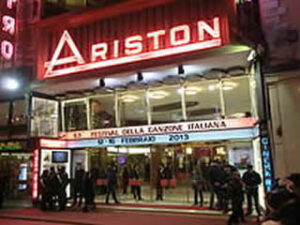
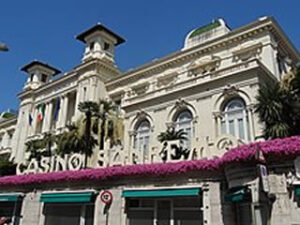
The Ariston Theatre is the site of the celebrated annual Sanremo Music Festival, which has been held in the city since 1951. The internationally famous song “Nel blu, dipinto di blu“, popularly known as “Volare”, was performed at this festival for the first time by Domenico Modugno in 1958.
Cinque Terre
The Cinque Terre, or “Five Lands” is a coastal area within Liguria, in the northwest of Italy. To the west of La Spezia Province, it is comprised of five villages: Monterosso al Mare, Vernazza, Corniglia, Manarola, and Riomaggiore. The coastline, the five villages, and the surrounding hillsides are all part of the Cinque Terre National Park, a UNESCO World Heritage Site. Vernazza is one of I Borghi più belli d’Italia (“The most beautiful villages of Italy”).
The Cinque Terre area is a very popular tourist destination. Over the centuries, people built terraces on the rugged, steep landscape right up to the cliffs that overlook the Ligurian Sea. Paths, trains, and boats connect the villages as cars can only reach them with great difficulty from the outside via narrow and precarious mountain roads. Car travel is not recommended.
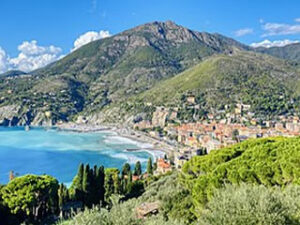
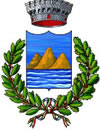 Monterosso al Mare
Monterosso al Mare
Like many towns located along the Italian Riviera, Monterosso al Mare boasts its own castle built centuries ago to help protect the community from invaders. The castle is located on a precarious cliff that separates Monterosso’s Old Town from the New Town. It is called Torre Aurora.
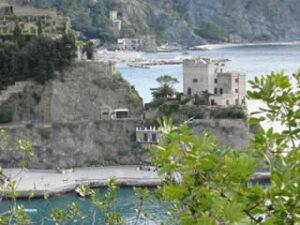
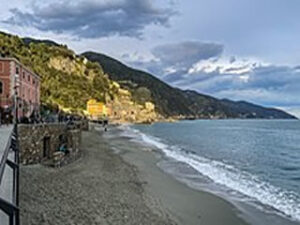
The town is divided into two distinct parts: the old town and the new town. The two areas are divided by a single tunnel used by pedestrians and the very few cars in the town.
The beach at Monterosso runs along most of the coast line and is overwhelmed tourists and locals. The beach is the only extensive sand beach in the Cinque Terre. Monterosso is a small town overrun by tourists in the summer months.
The area is famous for its many lemon trees that can be seen throughout Monterosso. It is also renowned for its white wines, grapes, and olives.
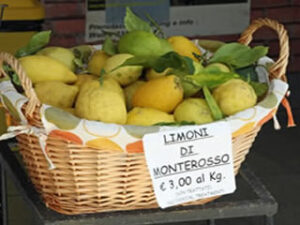
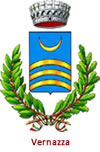 Vernazza boasts one of the truest fishing villages on the Riviera and has the only natural port of Cinque Terre as well asbeing one of the most beautiful villages in Italy. It is NOT accessible by car. History records it as a fortified town as early as 1080. Over the next two centuries it became a vital vassal of the Republic of Genoa providing port, fleet and soldiers.
Vernazza boasts one of the truest fishing villages on the Riviera and has the only natural port of Cinque Terre as well asbeing one of the most beautiful villages in Italy. It is NOT accessible by car. History records it as a fortified town as early as 1080. Over the next two centuries it became a vital vassal of the Republic of Genoa providing port, fleet and soldiers.
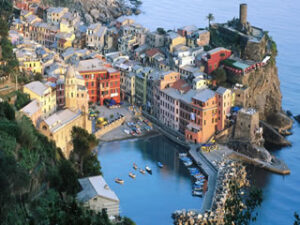
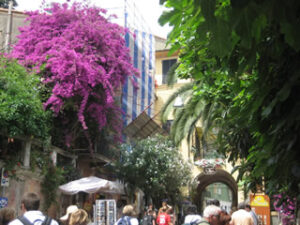
Located in the town’s main square, the Church of Santa Margherita d’Antiochia bult in 1318 is unique for its east-facing entryway. It has a nave and two aisles with octagonal bell tower rising from the apse area.
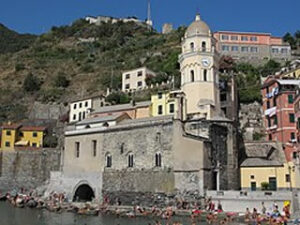

The local trail connects the five towns of the Cinque Terre including Vernazza. It is a unique experience.
Corniglia is the third village and the highest of the Cinque Terre. It dates from Roman times and is perched on a steep mountain between two exclusive beaches at it sides. To reach Corniglia, one must climb the Lardarina, steps composed of 33 flights with 383 steps, or follow he road from the station that leads to the village. The village follows the main road with houses on one side facing the road and the other side facing the sea. The coastal footpath links all five villages allowing you to hike from the first village to the last in about five hours. This is the true way to enjoy the Cinque Terre.
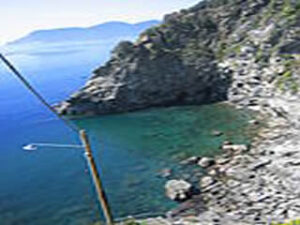 The marina of Corniglia.
The marina of Corniglia.
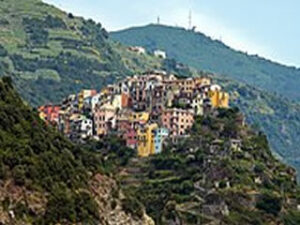
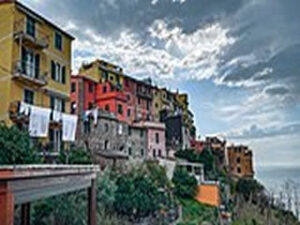
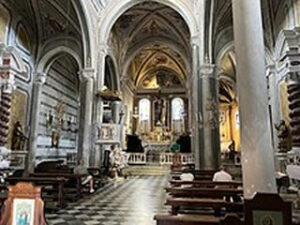
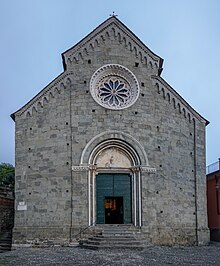
Chiesa San Pietro, was built between 1334-1351 using local stone. Inside there are three naves, seen on the left, three naves in the Baroque style. The baptismal font dates from the 12th century. In 2016, a 17th-century painting by the Corniglia painter Prospero Luxardi was placed next to the altar. This large oil painting on canvas depicts the mysteries of the Rosary and the Judgment. The rose window is made of white Carrara marble. The courtyard is paved with polychrome cobblestones.
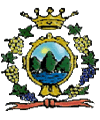 Riomaggiore is the last of the Cinque Tere villages resting in a small valley. It dates from the early thirteenth century. It is renowned for its wines produced in the town’s vineyards. It meets the sea on the Mediterraneans’s Gulf of Genoa with a small beach and a wharf with “tower houses”. It is connected to Manarola by the footpath called Via dell’Amore. It is the southern most village of the Cinque Terre all connected by rail. The water and the mountainside have been declared a national park.
Riomaggiore is the last of the Cinque Tere villages resting in a small valley. It dates from the early thirteenth century. It is renowned for its wines produced in the town’s vineyards. It meets the sea on the Mediterraneans’s Gulf of Genoa with a small beach and a wharf with “tower houses”. It is connected to Manarola by the footpath called Via dell’Amore. It is the southern most village of the Cinque Terre all connected by rail. The water and the mountainside have been declared a national park.
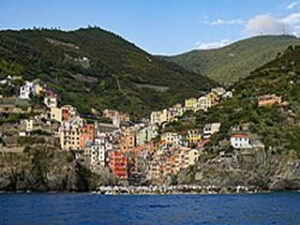
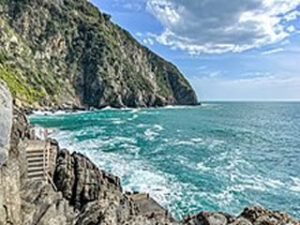
Be sure to visit the Castello of Riomaggiore overlooking the sea, finished in the 13th century after being initiated by the Marquis Turcotti in 1260. It is a square building characterized by its two circular towers on each side of the entrance. In the 19th century it was renovated and used as a cemetery. It can be reached by climbing the road which leads from the train station to the castle. Locally it is called Castellazzo of Cerrico.
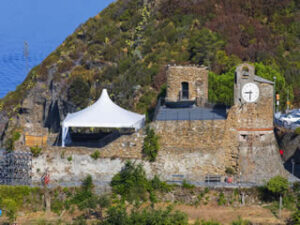
La Spezia
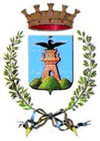 La Spezia Is the second largest city in Liguria, located between Genoa and Pisa on the Ligurian Sea. It has been settled since prehistoric times, but not dominated by the Romans.
La Spezia Is the second largest city in Liguria, located between Genoa and Pisa on the Ligurian Sea. It has been settled since prehistoric times, but not dominated by the Romans.

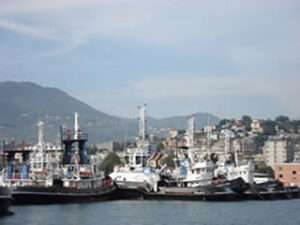
It is one of the main Italian military and commercial harbors and a major Italian Navy base. It is also a commercial port, with shipyards and industries producing machinery, metal products, and refined petroleum. It has a deep water harbor which accommodates even the largest cruise liners.
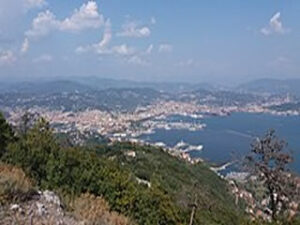
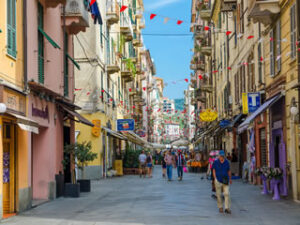
The Via del Prione is one of La Spezia’s busiest streets, a largely-pedestrianized thoroughfare lined with shops, and restaurants. Specialty cuisine includes Focaccia di Recco, Trofie with pesto and of course, fish.
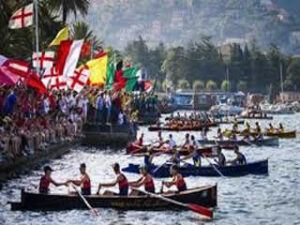
A popular seaside resort, it is also a significant railway junction, and is notable for its museums, for the Palio del Golfo rowing race held every year in the Gulf of La Spezia., and for railway and boat links with the Cinque Terre.
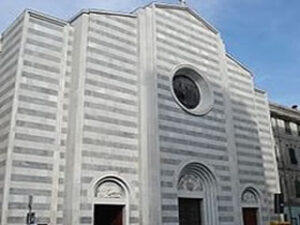
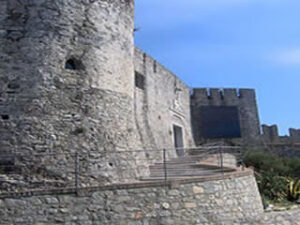
Be sure to visit the Church of Santa Maria Assunta built in the 13th century housing considerable artworks including the Incornation of the Virgin by Andrea della Robbia and many others. The Saint George Castle(right) overlooks the city; originated from a watchtower and was built in 1262. t houses an Archaelogical Museum with exhbits from the Neolithic, Copper, Bronze and Iron ages. In addition there is an extensive display of Roman artifacts. There are also magnificient views of the sea from th castle.
Genoa
 The magnificient city of Genoa is the capital of the Ligurian province on the Gulf of Genoa in the Ligurian sea. It is the sixth largest city in Italy and one of the most important and busiest ports in Italy.
The magnificient city of Genoa is the capital of the Ligurian province on the Gulf of Genoa in the Ligurian sea. It is the sixth largest city in Italy and one of the most important and busiest ports in Italy.
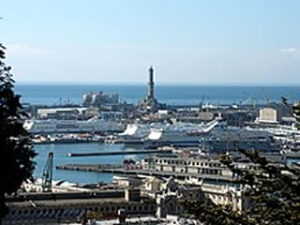
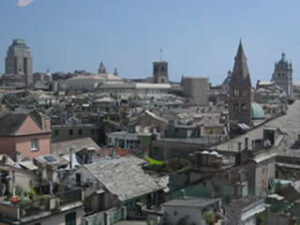
Genoa has been inhabited since the 5th or 4th millennium BC making it one othe oldest continuously inhabited cities in the world.
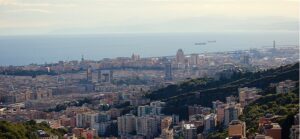
Genoa’s historic center consists of a maze of squares and narrow caruggi (alleys). Along these alleys and squares one finds some of the most splendid and beautiful palaces, churches and government buildings in the world.

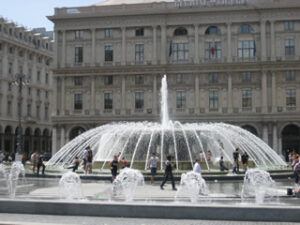
Ducal Palace Ferarri Fountain
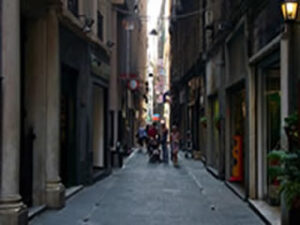
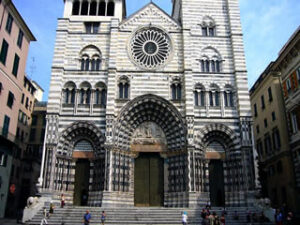
Caruggi San Lorenzo
Genoa through the centuries ha been protected by defensive walls surrounding the city. Some like the Porta Soprana (right) remain today and Genoa has more and longer walls than any other city in Italy.
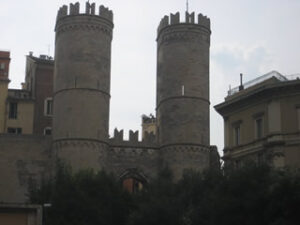
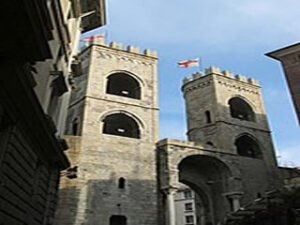
It is the center of technology innovation and service industries. It remains a center of the arts and culture: of Opera and theatre, of cinema hosting the Genoa Film Festival in July. Typical Genoese dishes include: trofie al pesto, pansotti in salsa di noci, cappon magro (a 16th century fish and vegetable dish). Genoese sweets are notable-pandolce, sacripantina, canestrelli and lagaccio.
The centro storico has a unique atmosphere filled with quaint shops selling tripe, poultry and baccala`, as well as goods of all kinds, the local specialties and exotic imported items.There is nothing missing here! The romantic Corso Italia promenade is irrestible at night shining with the lights of Boccadasse, a timeless hamlet at the end with its brightly colored houses and fishingboats reflected in the water near the little beach. Magnifico!
There is so much to see and do in Genoa. Find additional infrmation about Genoa under the Cities tab on the main menu.
Imperia
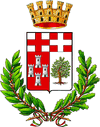 Imperia is a city along the coastline of the Liguria region. Mussolini created the city in 1923 combining Porto Maurizio and Oneglia as well as several surrounding villages. Imperia is renowned for the cultivation of flowers and olives. These two historical districts lie on either side of the River Impero from which the city gets its name.
Imperia is a city along the coastline of the Liguria region. Mussolini created the city in 1923 combining Porto Maurizio and Oneglia as well as several surrounding villages. Imperia is renowned for the cultivation of flowers and olives. These two historical districts lie on either side of the River Impero from which the city gets its name.
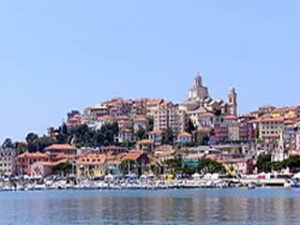
Porto Maurizio was originally a Roman settlement’ named after Saint Maurice who led a Theban legion of Rome killed by emperor Maximillian for refusing to murder Christians.

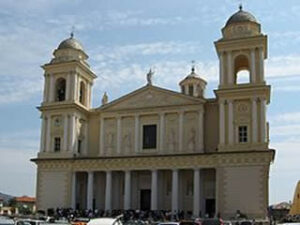
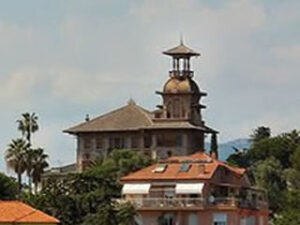
The Cathedral f San Maurizio (right) was constructed between 1781 and 1832 and is the largest church in Liguria. The Villa Grock is found in the Oneglia section of Imperia. It became the home of Adrien Wettach called the “King of Clowns” and was known as an international star who charmed audiences around the world. Today it is called the Museo del Clown.
There are many other interesting cities in Liguria. Be sure to visit the Cities Tab on the main menu for further information.
Things to Do in Liguria
Liguria is a long, thin crescent along the coast with mountains on one side and the sea on the other. It offers wildlife along with fascinating historic and artistic adventures.
Genoa’s Historic Acqueduct
Genoa’s historic aqueduct was built built in the Roman era in the valley the Bisagno River. It supplied Genoa with water at the start of the 12th century; it was enlarged and improved through the 1600s. It is a great hiking experience both for its historic value and its natural environment. It was operational until the 19th century.
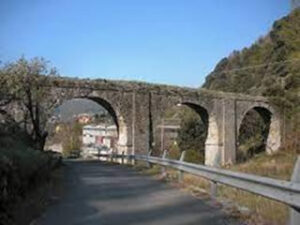
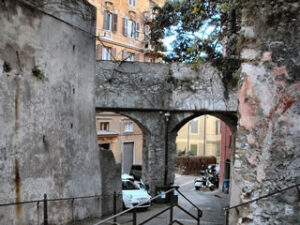
Visit the Acquarium in Genoa
The Acquarium in Genoa is rich in the display of acquatic biodiversity with over 400 speciaes and 12, 000 specimens from all over the world. It is the largest acquarium in Europe, originall built for the Genoa Expo ’92 comemorating 500 years since Columbus discovered the new world. It is loccated in the Porto Antico or Old Harbour area of Genoa. Its inhabitants include manatees, dolphins, penguins, sharks, jelly fish, seals and colorful tropical fish to name a few.
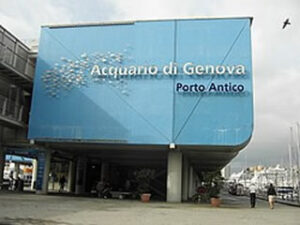
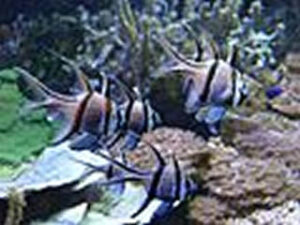
A great excursion for adults and children!
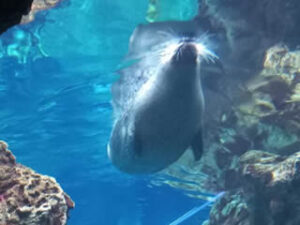
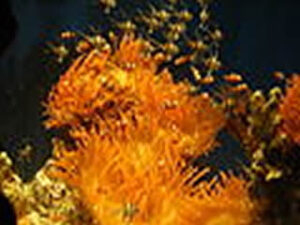
Explore the Genoa Pirate Ship
The Neptune pirate ship is a replica of the 17th century galleon built for Roman Polanski’s film “Pirates”. It is located in the port of Genoa and its interior can be visited.
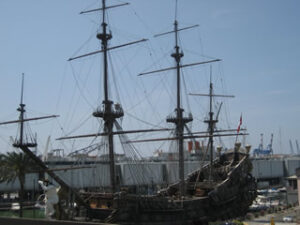
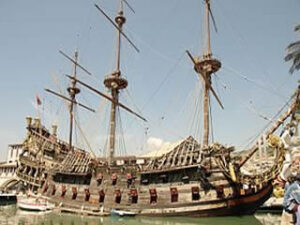
Visit the House where Christopher Columbus was born.
Cristoforo Colombo (Christopher Columbus) was born in the Italian seaport of Genoa in 1451 to a family of wool weavers. The current Columbus house is located outside Genoa’s 14th century walls. Columbus is said to have lived in this house from 1455 to 1470. The original house most klikely was destroyed in the bombardment of Genoa in 1684 and rebuilt in the 18th century over the original ruins. Currently it is two stories high. Today it operates as a museum.
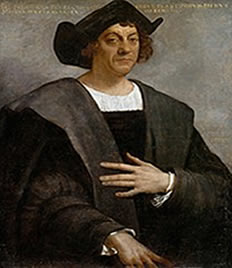
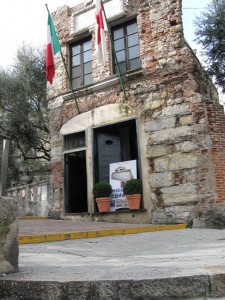
Explore the fishing village of Boccadasse
Boccadasse is an ancient mariners’ village found at the easternmost end of the main promenade of Genoa, Corso Italia. Its pastel colored houses and cobblestone beach have remained the samethrough time, making it a well-known tourist destination. Its people are still fishermen doing the traditional job the traditional way! Today ice cream shops, restaurants, bakeries, bars and art galleries have grown up there. Magnificent views of the Paradise Gulf and Portofino can be enjoyed from the square dedicated to the poet Edoardo Firpo.
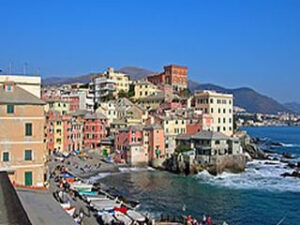
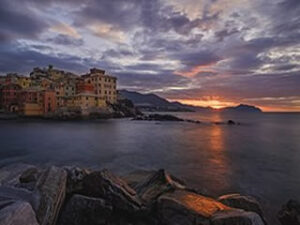
Experience the famous tastes of Liguria
Probably the most well-known Ligurian product throughout the world is pesto alla genovese, made with basil, pine nuts, garlic, parmesan and pecorino cheese, salt and extra virgin olive oil. It is the st famouse green sauce in the world. Another typical Ligurian delicacy is focaccia ligure– the Genoese eat it for breakfast with their cappuccino! Also, ty the focaccia di Recco made without yeast and filled with crescenza cheese.
If you adore cheeses be sure to enjoy cheese made with raw milk – prescinseua, formagetta and u cabanin. A prized native Genovese breed of cattle called Cabannina is responsible for these cheese delicacies.
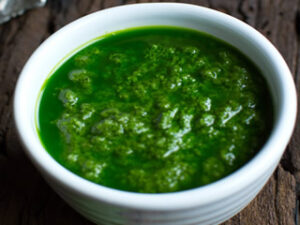

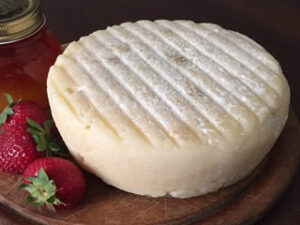
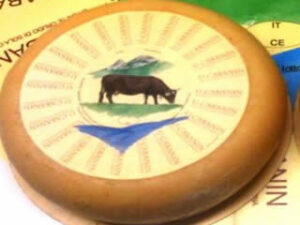
Cross over the medieval footbridge Ponte di Michele (Campo Ligure) 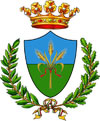
Built in the 9th century,the medieval bridge, called the Ponte di San Michele, over the Stura torrent is divided into four stone spans.
A flood in August 26, 1702 caused the demolition of a part of the structure, leaving the first arch towards the town center almost intact. The bridge was completely rebuilt in wood in 1721, but two other violent floods, in 1737 and 1747, completely demolished it. It was finally rebuilt in stone in 1836-37 and collapsed as soon as it was finished because of the builder’s inexperience.In 1841 the bridge was finally rebuilt.
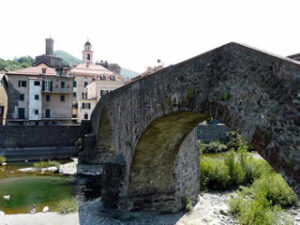
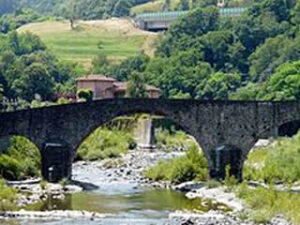
Visit the Medieval town of Sarzana 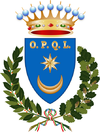
The town of Sarzana’s position at the entrance to the valley of the Magra made it of military importance during the Middle Ages. It is first mentioned in a diploma of Otto I in 983. The fortress stands on top of the Sarzanello hill overlooking the city and the plain fo the Val di Magra. The current structure was modified by Lorenzo di Medici transforming Sarzana into a fortified military outpost. The structure has a moat and consists of four floors with a walkway and various service areas used for everyday life. In the lower part there are perfectly preserved prisons and dungeons. It is still used for military exercises and is open to the public and used for cultural events.
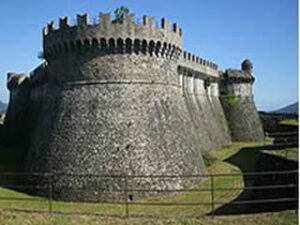
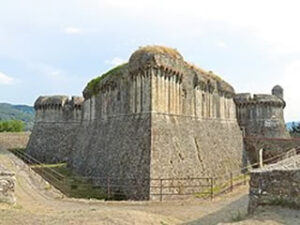
The Sarzana Cathedral is dedicated to theAssumption of the Virgin Mary., and is a mixture of Romanesque and Gothic style from the early 13th century to the late 15th century. There you will see a relic of St. Andrew and of the Blood of Christ. It is also noted for the Cross of Maestro Guglielmo dated from 1138, possibly the oldest Tuscan cross representing amore human and suffering Christ. It also includes many other important works of art.
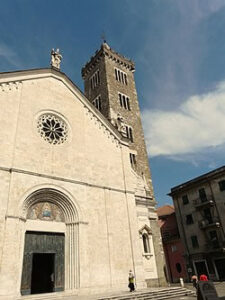
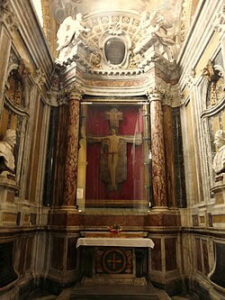
Visit Savona 
An ancient city inhabited by Ligures tribes, Savona came under Roman influence about 180 BC and after many strugles against the Saracens became independent. Visit the Cathedral dell’Assunta to see the relics of Saint Valentine.
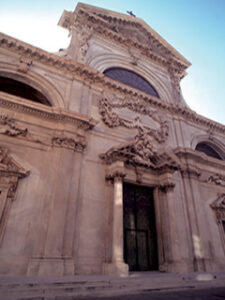
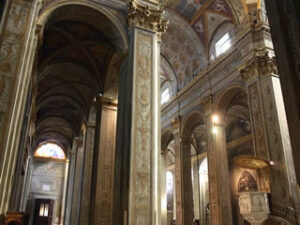
While you are there, be sure to visit The Snactuary of Nostra Signora della Misericordia built to commemorate the apparition of the Virgin to Blessed Antonio Botta in 1536 during the war between Savona and Genoa inviting both parties to exercise “Misericordia e non Giustizia” ( Mercy and not Justice.). Inside you will see many precious works of art.
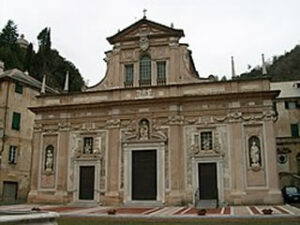
Visit Priamar, the Fortess of Savona
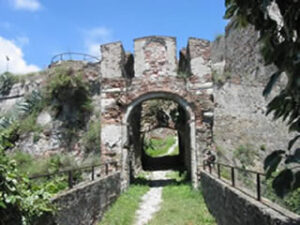
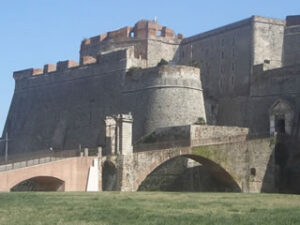
The Fortress of Savona was built by the Republic of Genoa between 1542 and 1544 to protect and defend the area from attacks by the Savoy and maintain Genovese control over the city. Over time, the whole complex was extended and remodelled, even used as a jail to hold the famous Italian patriot Giuseppe Mazzini. His cell is open to visitors. The entire compound was restored by the city and has been transformed into a tourist destination and cultural venue, as well as a conference center and an open air theater. Magnificient experience.
This is only small sampling of things to do. Be sure to visit the Cities for information about other cities and destinations.
